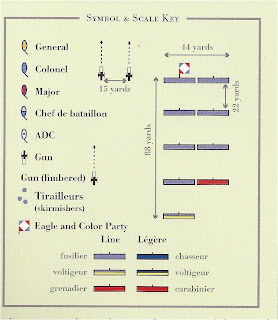Saturday, August 10, 2013
French Column of Division Intervals
Should French battalions deployed in Columns of Divisions use intervals? They were used historically. Therefore, so should we. Pictures are worth a thousand words so....
Each of my five French battalions is screened by their voltigeurs. Behind them each battalion has a two company wide front. Every two companies deployed this way is a division - a small d. Jim pointed out the checkerboard arrangement that could be used as shown.
When intervals are violated, confusion and disorders happen. There is insufficient room to change formation into line or square. It would be a traffic jam at quitting time!
As we move in closer, two battalions are separated by a bit more than a six inch ruler. Within that interval lights can move forward and back, cannons might be deployed and the gap might be useful to bring up rearward battalions not to form a massive unbroken wall, but to move them farther forward. It could be used to provide an open space for messengers and routers too.
Forming a line is also the idea. The right-hand battalion could form line to the right. The other one would form to the left and right of itself because a third battalion is to the left off image. See the first photo. The battalion off image would form to its left.
The 9th Foot's two-deep line is screened by Rifles with a two company reserve. Rules need to be implemented so fire into the deep columns is prodigiously effective with possibilities of disorder. Plus the celebrated fire and charge concept is needed to cause morale checks to rout the French. If none of this occurs, the 9th Foot is going to be beaten. Polite comments welcome.
Jim's Der Alte Fritz blog has some very good commentary and historical illustrations reinforcing the above concepts. See the link below:
Link = Der Alte Fritz Journal
The diagrams above are from the book Napoleon's Finest, Davout and His 3rd Corps, Combat Journal of Operations, 1805-1807, Military History Press, 2006, Page 66.
Respectfully,
Bill P.
-----------------------------
Subscribe to:
Post Comments (Atom)






Bill,
ReplyDeleteThese two related discussions on your respective blogs help to make this (sometimes) confusing subject crystal clear. Much clearer than many books on the subject actually. Thanks!
Best Regards,
Stokes
Merci Stokes!
ReplyDeleteCheers,
Bill
I can't say better than that - text book stuff!
ReplyDeleteCheers, JJ
My understanding is that the "fire and charge" was exploiting the confusion of French columns surprised and trying to react and/or deploy. When you didn't have the British hidden from French view - as at Albuera, pieces of Quatre Bras, or some of the fights in Eastern Spain - then things did not all go the British way.
ReplyDeleteI only see two solutions: hidden British deployment, or variable time moves.
Hidden deployment covers the surprise factor, and possibly gives the British the chance to get their fire and their charge in. However, I can see French players getting mighty tired of essentially walking into a buzzsaw all game periods.
To counter that, you may want to incorporate variable timeframes. One of my personal favorite rules does this, where the amount of time (and thus actions) a unit has available to it is variable - from 1-3 per turn, decided by card draw. Will the British be able to fire, or will the French have the time to deploy into line once sighted?
Very nice pictures and post, very interesting work!
ReplyDeletePhil.
This comment has been removed by the author.
ReplyDelete!
ReplyDeletewow nice job, Its a great blog!
http://napoleonic-spain.blogspot.com.es/
We (wargamers) are generally terrible exponents of the gapless deployment aren't we?!
ReplyDelete